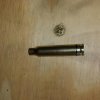Verify, you want to know if the case was sized when the ram was raised? The deck height of the shell holder is .125”, if the case is returned to minimum length/full length sized there will be a case head protrusion of .125” from the die.
Verify, rotate the shell holder until it can be removed from the ram and case at the same time before lowering the ram, after removing the shell holder remove the die from the press then measure the protruding case head, the case head protrusion form the die should be .125” if the case was restored to minimum length.
I have 4 RCBS Rock Chuckers, none of them cam over, I can modify the Rock Chucker to cam over but, that would defeat the design. A few years ago on YouTube a video was made at a Cabels of a Rock Chucker being put through its paces. To the dismay of the person making the video he observed the ram of the press tilt forward at the top, there was no die in the press, there was no case in the shell holder, the press was in the idle configuration. My Rock Chuckers do not cam over, I have 7 Herters, all of my Herters cam over, there is a reason my Herters cam over.
Technique, adjusting the Rock Chucker for full length sizing is different than adjusting the RCBS A 2 press, the A2 is a cam over press.
F. Guffey



